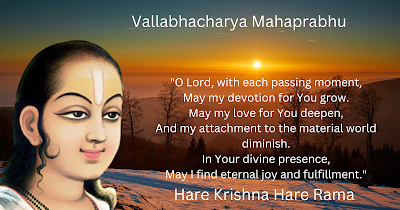Vallabhacharya Mahaprabhu
A well-known Hindu philosopher, scholar, and saint who lived in the 15th century in India was known as Vallabhacharya, also known as Vallabha or Vallabhacharya Mahaprabhu. He was the creator of the Vaishnavism branch of Hinduism's Pushti Marg, also known as the Path of Grace, which is a devotional tradition. The teachings of Vallabhacharya focused on the path of Bhakti (devotion) and emphasised the love connection between a human soul (jiva) and the Supreme Being (Shri Krishna).
Vallabhacharya is well renowned for his intellectual teachings and contributions to the Vaishnava tradition; but, as you noted, he is not frequently connected with the creation of devotional songs called Kreethanigal. However, Vallabhacharya did write a number of devotional poems and writings that are generally referred to as "Vallabhacharya's Pada" or "Vallabhacharya's Stotra." These songs display intense emotion.
The "Shodasha-grantha," a collection of sixteen philosophical treatises that summarise Vallabhacharya's teachings and the tenets of Pushti Marg, is his most well-known work. These writings, which are regarded as Vallabhacharya's main philosophical source, have had a considerable influence on the growth of Vaishnavism.
Even while some of the devotional hymns or Kreethanigal specifically attributed to Vallabhacharya may not be well known, his philosophical writings and teachings have inspired numerous followers throughout the Vaishnava tradition to create and sing devotional melodies in adoration of Lord Krishna.
It is noteworthy that many devotional songs and bhajans in the Pushti Marg tradition were written by Vallabhacharya's pupils and later followers, and are sung by devotees as a part of their worship and devotion. These works frequently convey Vallabhacharya's fundamental ideas and teachings.
I advise perusing the works attributed to Vallabhacharya and the devotional songs written in the Pushti Marg tradition if you are especially seeking for his compositions. These can be discovered through reading books, using online resources, and speaking with others who follow Vallabhacharya's teachings.
To learn and listen Vallabhacharya's devotional hymns follow this blog. Checkout our next blog.


.png)
Comments
Post a Comment